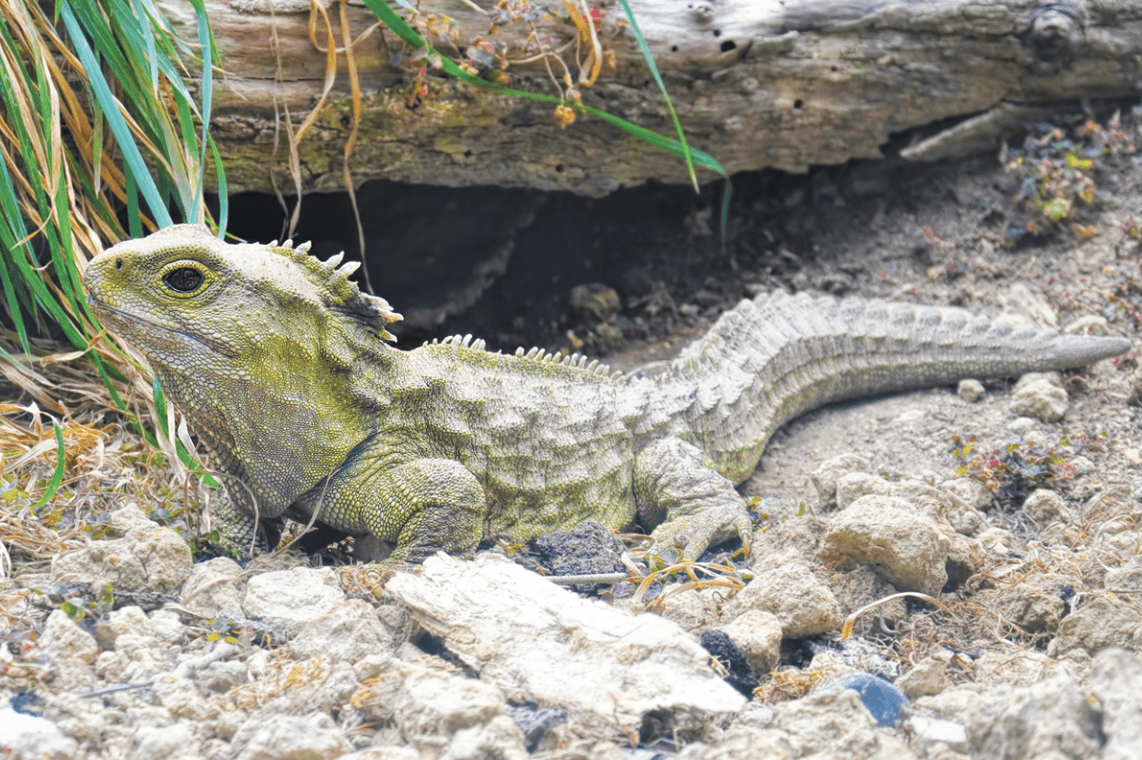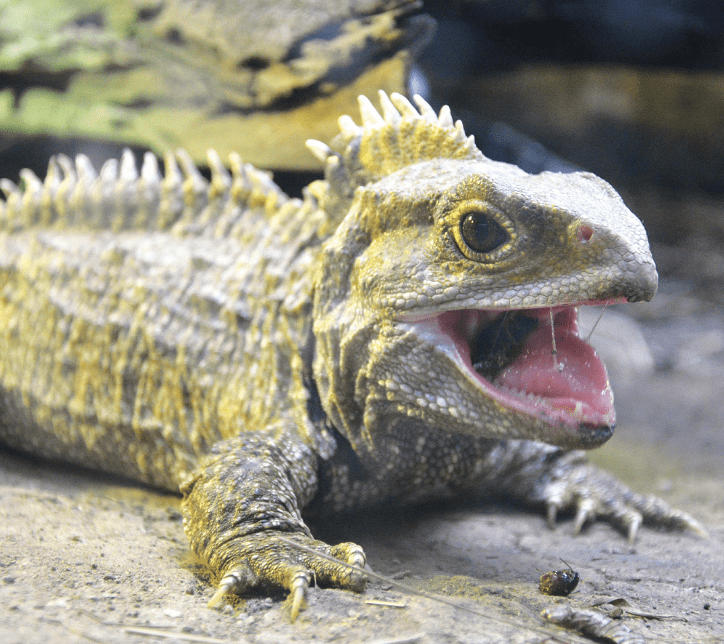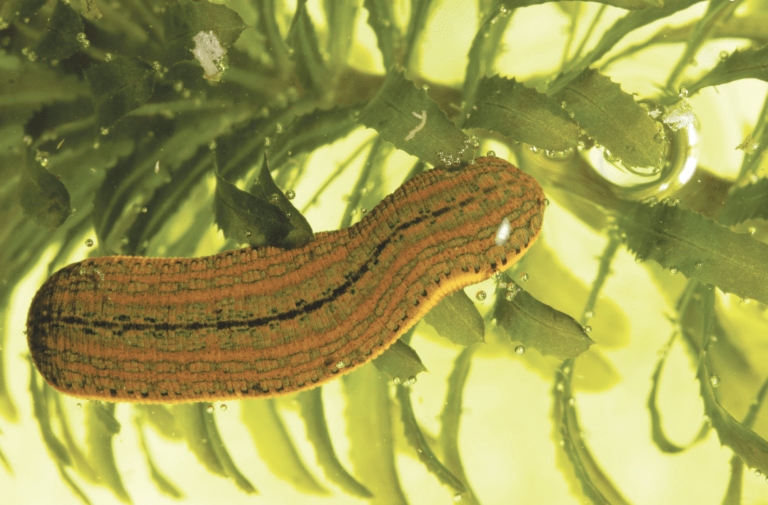
Mother Nature is an inventor, and her inventions are often as puzzling as they are diverse. With so many life forms fulfilling so many natural functions, we are just beginning to truly chronicle species and their impossibly rich interconnectedness. From mammals that look like reptiles, such as the pangolin, to birds that look like plants, such as the Kea, nature’s creatures often strain our powers of discernment.
Meet the Tuatara. Ranging from 18-31 inches and 1-3 pounds in weight, this four-legged, olive-brown, long-tailed reptile resembles its lizard cousins, but appearances can be deceiving. Described by scientists as “dinosaur-like,” “utterly unique,” and “one of a kind,” the Tuatara is a creature like no other. As the sole surviving member of its order, Rhynchocephalia, the Tuatara has retained the physical features of its Mesozoic ancestors and represents this ancient reptilian lineage which arose 240 million years ago! Regarded as primitive among its reptilian kin, even within the Class Reptilia, the Tuatara is in a class by itself.
Indigenous solely to New Zealand, and now confined to just 37 uninhabited small islands and islets and the Zealandia Wildlife Sanctuary outside Wellington, the Tuatara has full governmental protection and stands a species of national pride and international renown. The name Tuatara is a Māori word which translates to, “peaks on back” referring to the reptiles’ crest of spiked scales or spines extending down the back and tail.
From their heads to their tails, everything about these fascinating reptiles is unique and remarkable. A reptilian contrarian of sorts, the nocturnal Tuatara likes it dark…and cold. As a member of an ancient lineage, Tuataras lack the outer ears of their look-alike lizard cousins, yet they possess a rare sensory advantage—a third eye. Known as the parietal or pineal eye, it is located on the top center of the Tuatara’s skull and features a lens, retina, and nerve endings just like its forward-facing eyes. Though covered with skin, pigment, and scales, this pineal eye is highly functional as a light sensor to tell time of day. It also detects seasonal light cycles, regulates circadian rhythm, and may even aid the Tuatara to navigate under cloud cover or under the stars! This is in addition to its independently focusing eyes which feature a third eyelid and a reflective layer of cells on the back of the eye—the tapetum lucidum—which boost light levels. This night vision capability confers a huge advantage to this nocturnal reptile.
This nighttime active mode enables these adorable yet capable little carnivores to emerge from their burrows to put the bite on their prey…and that bite is formidable. Part of the Tuatara’s success lies in its specialized skull and teeth. Unlike other reptiles, the Tuatara’s upper teeth grow from the bones on the roof of its mouth. Similarly, its teeth and jawbones are fused, generating great force when put into action. Additionally, the Tuatara’s single row of lower teeth nest perfectly between its double rows of upper teeth when the Tuatara clamps down on beetles and other insects. This power and clamping grip is further aided by the Tuatara’s chisel-like front teeth which enable them to successfully tackle larger more agile prey including birds and lizards. The nesting and shearing action of the Tuatara’s triple rows of teeth produces a shell-crunching, bone-crushing bite which is second to none. In fact, the Tuatara is so formidable a predator, hatchlings adopt a wholly diurnal existence to avoid ending up on the menu of their larger kin.
It’s not just the Tuatara’s physical adaptations that have enabled it to survive virtually unchanged for millions of years. It is this survivor’s behavioral adaptations that have brought it to the present day in fine Mesozoic form. By thriving in cooler conditions than nearly all other reptile species, the Tuatara outstrips the competition. When it comes to reproduction, Tuataras lay up to 19 eggs which take 11-16 months to incubate. However, the Tuatara exhibits a very rare trait in the animal kingdom—egg development which can arrest yet remain viable during cooler than average temperatures. Add in autotomy—the ability to regrow a tail lost to predators and a 91-year lifespan—decades longer than the world’s longest-lived lizards, and you have one resilient reptile.
Yet even the world’s most resilient creatures can use a helping hand in this age of rapid habitat change and introduced species. Accredited zoos such as the San Diego Zoo are working with the government of New Zealand to bank frozen genetic tissue from Tuataras as a safeguard toward their survival in the 21st century and beyond.
In our world, primitive often connotes inefficiency and low functioning—a thing whose time has passed. In nature, the opposite holds true. In nature, primitive means a species prevails above the competition, functioning to such a fine degree, it hasn’t changed because it is perfectly suited to perform its biological functions. In short, primitive is beautiful.
In the Tuatara we have a truly primitive species, a creature whose ancestors were contemporaries of dinosaurs, a true survivor. In the Tuatara, we also have Mother Nature’s inventive handiwork showing us that a contrary nature and a dash of resilience can go a long, long, way.
Jim Knox serves as the Curator of Education for Connecticut’s Beardsley Zoo and as a Science Adviser for The Bruce Museum. His passions include studying our planet’s rarest creatures and sharing his work with others who love the natural world.





